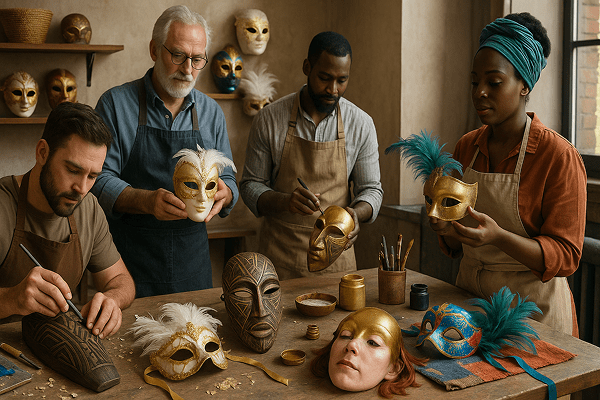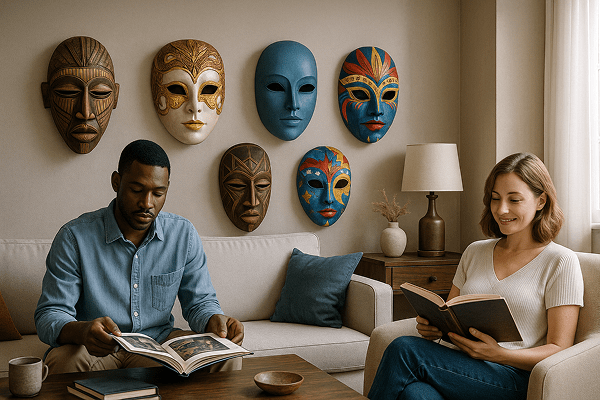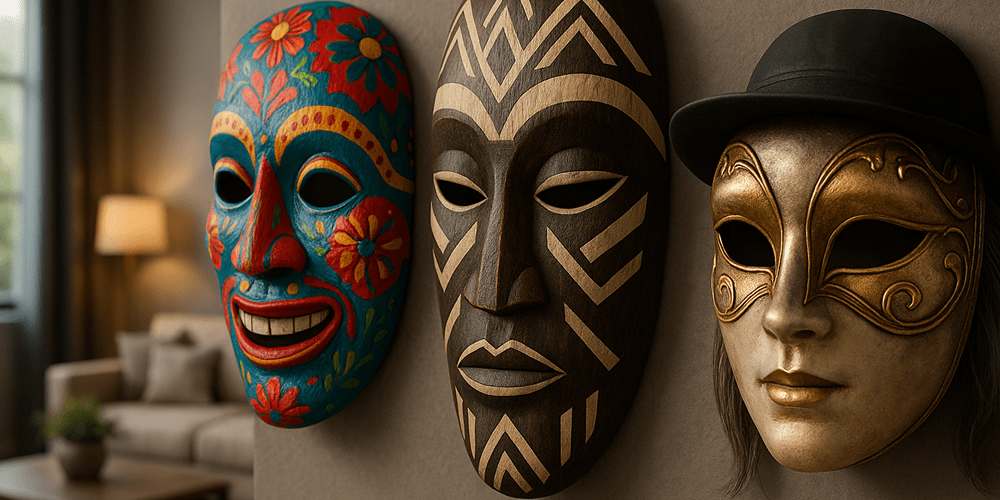Decorative Interior Design Masks are a striking blend of art and function, transforming living and work spaces into environments rich with culture, personality, and visual intrigue. These masks are specifically created for display in modern interiors — from homes and offices to hotels and galleries. They range from minimalist and contemporary to ornate and traditional, crafted in materials such as wood, ceramics, metal, glass, or mixed media. Notable features of interior design masks include bold forms, harmonious color palettes, and finishes that complement current architectural and design trends. While drawing inspiration from world mask traditions, today’s Decorative Interior Design Masks are tailored to fit the aesthetics and sensibilities of 21st-century interiors, making them a popular choice for collectors, decorators, and art lovers. For those interested in related art objects, Collectible Masks also play a significant role in interior styling — see more at toddmasks.com.
Historical Origins of Decorative Interior Design Masks
The use of masks as decorative objects dates back to ancient civilizations, where masks were not only worn in rituals but also displayed in homes, temples, and palaces for protection, inspiration, or status. The word “mask” comes from the Latin “masca,” meaning spirit or ghost, reflecting their symbolic and often mystical use.
With the rise of the Renaissance, Baroque, and later periods, masks transitioned from ceremonial regalia to objects of art, collected and displayed by European aristocrats and travelers. In the 19th and 20th centuries, as global travel and trade increased, decorative masks from Africa, Asia, Oceania, and the Americas found their way into Western interiors, sparking new trends in design and collecting. The 20th-century modernist movement embraced masks for their abstract qualities, while postmodern and contemporary designers reinvented them as statement pieces for the modern home.
Cultural Significance and Symbolism of Decorative Interior Design Masks
Decorative Interior Design Masks carry layers of meaning, depending on their origin and context. In some cultures, masks are believed to protect the household, bring luck, or ward off evil spirits. In others, they symbolize prosperity, fertility, or wisdom. Displaying a mask in the home can represent a connection to heritage, worldliness, or appreciation of fine art.
Myths and stories often surround decorative masks: African house masks may invoke ancestors, Asian masks might depict gods or legendary heroes, and Latin American masks can reflect community celebrations or historic events. In modern interiors, masks often serve as conversation pieces, symbolizing individuality, artistic taste, and a sense of adventure.
Materials and Crafting Techniques of Decorative Interior Design Masks
Interior design masks are crafted from a wide range of materials, chosen for durability, texture, and aesthetic appeal. Common materials include:
- Carved wood (mahogany, teak, cedar, or sustainable varieties)
- Painted or glazed ceramics and porcelain
- Forged and polished metals (bronze, copper, steel)
- Glass fused or blown in contemporary shapes
- Papier-mâché, resin, or composite materials
- Textiles, beads, and organic embellishments
The crafting process usually involves:
- Designing to match interior proportions and styles
- Carving, molding, or shaping the base
- Sanding, polishing, or glazing for a finished look
- Painting, staining, or metallic leaf application
- Attaching hanging hardware, stands, or frames
Regional differences persist: African-inspired masks might emphasize geometric carving and earthy tones, while Venetian-inspired masks feature metallics, feathers, and vibrant colors. Color symbolism is used to create mood or convey meaning — warm tones for energy, blue for calm, gold for luxury, and white for purity.

Functions and Uses of Decorative Interior Design Masks
The primary function of Decorative Interior Design Masks is aesthetic enhancement. They are used to:
- Serve as focal points or accent pieces in living rooms, bedrooms, hallways, or offices
- Add texture, color, and dimension to walls and shelves
- Reflect the cultural tastes and travels of the homeowner
- Complement themes such as global, bohemian, minimalist, or eclectic interiors
- Celebrate holidays or mark special occasions (e.g., Carnival, Halloween, New Year)
While their ritual and ceremonial functions have faded, interior design masks continue to serve as symbols of creativity, protection, and personal identity.
Regional Variations of Decorative Interior Design Masks
Designers draw on global traditions to create uniquely regional interior design masks:
- African-inspired masks: Emphasize bold carving, earth tones, and symbolic motifs.
- Asian-inspired masks: Feature serene expressions, lacquer finishes, and mythological imagery.
- European-inspired masks: Reference Venetian Carnival, commedia dell’arte, and folk styles.
- Latin American-inspired masks: Showcase vivid colors, festival motifs, and Day of the Dead iconography.
- Contemporary masks: Experiment with abstraction, minimalism, or mixed media.
Each region brings its own materials, colors, and techniques, allowing decorators to match masks with diverse interior styles.
Famous Examples and Notable Collections of Interior Design Masks
Prominent examples of Decorative Interior Design Masks can be found in:
- The Metropolitan Museum of Art (New York): World masks in modern gallery settings
- Victoria and Albert Museum (London): Decorative and contemporary art masks
- Private collections and design showrooms: Bespoke and artist-signed masks
Interior designers often commission custom masks for luxury homes, hotels, and public spaces. Online galleries and resources at toddmasks.com showcase both classic and cutting-edge designs.
Influence of Interior Design Masks on Art and Culture
Decorative Interior Design Masks have influenced visual art, architecture, and product design. Their forms inspire abstract painting, sculpture, and even furniture design. In literature and cinema, masks symbolize transformation, mystery, and the intersection of art and life. In fashion and home decor, mask motifs appear in textiles, wallpaper, and accessories, reflecting the enduring appeal of mask imagery.
The display of masks in interiors helps preserve and celebrate world cultures, fostering appreciation for traditional arts and contemporary creativity.

Contemporary Status and Preservation of the Interior Design Mask Tradition
The tradition of decorating with masks is thriving in the 21st century. Artisans and designers blend old and new techniques, using sustainable materials and digital tools. Design schools, museums, and online platforms like toddmasks.com offer educational programs, masterclasses, and curated exhibitions.
Modern adaptations include modular mask installations, smart lighting integration, and collaborations with visual artists. Annual design fairs and interior design magazines feature the latest trends, ensuring that mask art remains at the forefront of contemporary decor.
Collecting and Acquiring Decorative Interior Design Masks
The market for interior design masks ranges from affordable artisan pieces to rare, high-end artworks. Authentic masks can be found at galleries, art fairs, design boutiques, and online at platforms like toddmasks.com. Prices vary by material, craftsmanship, artist reputation, and provenance.
Tips for collectors:
- Choose masks that harmonize with your interior style
- Look for original designs and quality craftsmanship
- Support living artisans and ethical sourcing
- Avoid mass-produced or counterfeit items
- Consider documentation, display methods, and conservation
For those interested in a broader collecting focus, Collectible Masks can also enhance interior design and offer unique investment value.
